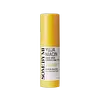What's inside
What's inside
 Key Ingredients
Key Ingredients

 Benefits
Benefits

 Concerns
Concerns

 Ingredients Side-by-side
Ingredients Side-by-side

Citrus Junos Fruit Extract 37%
Skin ConditioningButylene Glycol
HumectantBis-PEG-18 Methyl Ether Dimethyl Silane
EmollientGlycerin
HumectantNiacinamide 5%
SmoothingSodium Stearate
CleansingPentylene Glycol
Skin Conditioning1,2-Hexanediol
Skin ConditioningAllantoin
Skin ConditioningEthylhexylglycerin
Skin ConditioningMelaleuca Alternifolia Leaf Extract
PerfumingCentella Asiatica Extract
CleansingPolygonum Cuspidatum Root Extract
AntioxidantScutellaria Baicalensis Root Extract
AstringentCamellia Sinensis Leaf Extract
AntimicrobialRosmarinus Officinalis Leaf Extract
AntimicrobialGlycyrrhiza Uralensis Root Extract
Skin ConditioningChamomilla Recutita Flower Extract
MaskingBHT
AntioxidantPanthenol
Skin ConditioningArginine
MaskingGlutathione
Biotin
AntiseborrhoeicSodium Ascorbyl Phosphate
AntioxidantAscorbyl Tetraisopalmitate
AntioxidantArbutin
AntioxidantTocopheryl Acetate
AntioxidantFolic Acid
Skin ConditioningPyridoxine Hcl
Skin ConditioningGlyceryl Linoleate
EmollientMadecassoside
AntioxidantCI 19140
Cosmetic ColorantCentella Asiatica Leaf Extract
Skin ConditioningAsiaticoside
AntioxidantGlyceryl Linolenate
EmollientGlycyrrhiza Glabra Root Extract
BleachingGlyceryl Arachidonate
EmollientMadecassic Acid
Skin ConditioningAsiatic Acid
Skin ConditioningPalmitoyl Dipeptide-10
Skin ConditioningPalmitoyl Tetrapeptide-7
Skin ConditioningPalmitoyl Tripeptide-1
Skin ConditioningAscorbyl Palmitate
AntioxidantParfum
MaskingLimonene
PerfumingCitrus Junos Fruit Extract 37%, Butylene Glycol, Bis-PEG-18 Methyl Ether Dimethyl Silane, Glycerin, Niacinamide 5%, Sodium Stearate, Pentylene Glycol, 1,2-Hexanediol, Allantoin, Ethylhexylglycerin, Melaleuca Alternifolia Leaf Extract, Centella Asiatica Extract, Polygonum Cuspidatum Root Extract, Scutellaria Baicalensis Root Extract, Camellia Sinensis Leaf Extract, Rosmarinus Officinalis Leaf Extract, Glycyrrhiza Uralensis Root Extract, Chamomilla Recutita Flower Extract, BHT, Panthenol, Arginine, Glutathione, Biotin, Sodium Ascorbyl Phosphate, Ascorbyl Tetraisopalmitate, Arbutin, Tocopheryl Acetate, Folic Acid, Pyridoxine Hcl, Glyceryl Linoleate, Madecassoside, CI 19140, Centella Asiatica Leaf Extract, Asiaticoside, Glyceryl Linolenate, Glycyrrhiza Glabra Root Extract, Glyceryl Arachidonate, Madecassic Acid, Asiatic Acid, Palmitoyl Dipeptide-10, Palmitoyl Tetrapeptide-7, Palmitoyl Tripeptide-1, Ascorbyl Palmitate, Parfum, Limonene
 Reviews
Reviews

Ingredients Explained
These ingredients are found in both products.
Ingredients higher up in an ingredient list are typically present in a larger amount.
Niacinamide is a multitasking form of vitamin B3 that strengthens the skin barrier, reduces pores and dark spots, regulates oil, and improves signs of aging.
And the best part? It's gentle and well-tolerated by most skin types, including sensitive and reactive skin.
You might have heard of "niacin flush", or the reddening of skin that causes itchiness. Niacinamide has not been found to cause this.
In very rare cases, some individuals may not be able to tolerate niacinamide at all or experience an allergic reaction to it.
If you are experiencing flaking, irritation, and dryness with this ingredient, be sure to double check all your products as this ingredient can be found in all categories of skincare.
When incorporating niacinamide into your routine, look out for concentration amounts. Typically, 5% niacinamide provides benefits such as fading dark spots. However, if you have sensitive skin, it is better to begin with a smaller concentration.
When you apply niacinamide to your skin, your body converts it into nicotinamide adenine dinucleotide (NAD). NAD is an essential coenzyme that is already found in your cells as "fuel" and powers countless biological processes.
In your skin, NAD helps repair cell damage, produce new healthy cells, support collagen production, strengthen the skin barrier, and fight environmental stressors (like UV and pollution).
Our natural NAD levels start to decline with age, leading to slower skin repair, visible aging, and a weaker skin barrier. By providing your skin niacinamide, you're recharging your skin's NAD levels. This leads to stronger, healthier, and younger looking skin.
Another name for vitamin B3 is nicotinamide. This vitamin is water-soluble and our bodies don't store it. We obtain Vitamin B3 from either food or skincare. Meat, fish, wheat, yeast, and leafy greens contain vitamin B3.
The type of niacinamide used in skincare is synthetically created.
Learn more about NiacinamidePentylene glycol is typically used within a product to thicken it. It also adds a smooth, soft, and moisturizing feel to the product. It is naturally found in plants such as sugar beets.
The hydrophilic trait of Pentylene Glycol makes it a humectant. As a humectant, Pentylene Glycol helps draw moisture from the air to your skin. This can help keep your skin hydrated.
This property also makes Pentylene Glycol a great texture enhancer. It can also help thicken or stabilize a product.
Pentylene Glycol also acts as a mild preservative and helps to keep a product microbe-free.
Some people may experience mild eye and skin irritation from Pentylene Glycol. We always recommend speaking with a professional about using this ingredient in your routine.
Pentylene Glycol has a low molecular weight and is part of the 1,2-glycol family.
Learn more about Pentylene Glycol